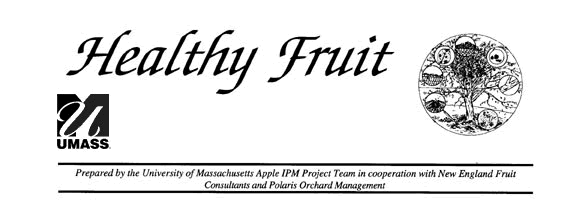
|
|
|---|
Last week, we reported that mild infestations of San Jose scale were cropping up in orchards that have had SJS problems in the past. However, observations over the past week have revealed that SJS is more widespread than in most years, and pockets of moderate infestation have been seen even in orchards that do not have a perennial SJS population. Growers would be well advised to keep an eye out for this inconsistent pest to avoid surprises at harvest. If a spray is deemed necessary, we recommend use of Lorsban in the next week or so.
Should the warm, dry weather pattern of the past few weeks continue, many growers may face a threat from red mites, usually seen as bronzing, premature fruit drop and poor fruit color. With rapid mite development stimulated by favorable weather conditions, some blocks treated with an early-season miticide are beginning to show signs of breaking control. In most orchards that received only a double-oil program, ERM populations have been building very quickly over the past 2 weeks. Many growers have found it necessary to treat such areas with a summer rescue application.As reported in the last several issues of Healthy Fruit, Pyramite stands as the mainstay summer miticide. Kelthane, Carzol, and Vendex will all offer marginally predictable control and these, along with Vydate, may be best suited for use in areas where the crop load does not justify the cost of using Pyramite.
Roughly 10% of monitored orchards are showing very high third-generation leafminer populations. In a season such as this one, when pest development has been consistently ahead of schedule, growers may gain some advantage from treatment against leafminer adults. In blocks that contain extremely large numbers of second-generation mines (more than 2 mines per leaf), growers might consider a treatment of Vydate against the third-generation adults.
Many growers have been experiencing higher than normal white apple leafhopper populations this year, possibly due to reductions in the use of Sevin and Provado this season. If WALH numbers are currently high, they may well be overwhelming by harvest. If the population is considered to be excessive, growers should consider applying a low rate of Provado (1 oz./100 gal.) or a half-rate of Thiodan. Such an application will be most effective if made in the next week or so.
As reported in New York and Massachusetts in the past couple of years, some orchards are beginning to see moderate infestations of a third species of leafminer, the apple leafminer. The following is taken from the 1998 March Message, condensed from the New York state newsletter, "Scaffolds".Unlike the mines of spotted tentiform leafminer and apple blotch leafminer, which have a stippled appearance, mines of the apple leafminer appear as brown blotches. Also, ALM constantly expels excrement on a silken thread from the mine, which ABLM and STLM do not do. Finally, just before pupating, ALM larvae spin cocoons which are suspended by threads and resemble a hammock. ALM has 4 to 6 generations per year in the Hudson Valley, whereas ABLM and STLM have only 3 per year. Of particular importance is the fact that larval damage of ALM is confined to the youngest foliage, especially terminal leaves of vigorously growing shoots and watersprouts. Severely damaged leaves tend to drop off prematurely, thereby decreasing the number of the most capable leaves. Potential for economic injury is greatest in young blocks, which can ill afford to suffer reduced photosynthesis. Infestations of ALM are most apparent toward harvest. Fortunately, such infestations are not known to cause premature fruit drop. ALM do not seem to be controlled by organophosphate insecticides, but apparently are susceptible to the same materials effective against ABLM and STLM. Sprays against ALM may be needed only on non-bearing trees where vigor is essential or on bearing trees that had high infestation the previous year.
Nymphs of the newest generation are currently active in monitored orchards. Now is a good time to treat if the population is too high, with either Mitac or Pyramite.
There's increasing evidence that calcium chloride can reduce flyspeck and other summer diseases, including bitter rot and black rot. Not only that, but regular calcium chloride will also improve storagability and fruit texture.So, as we enter the home stretch for summer disease management, consider using calcium chloride to help overall fruit quality. Monitoring shows that flyspeck spores are moving into the orchards as of this past week. In addition, the warm, humid nights are ideal for flyspeck growth. While calcium chloride alone won't completely stop flyspeck and other summer diseases, calcium chloride with relatively low rates of captan will do a good job. With normal rates of calcium chloride (3 lbs./100 gal. of 29% calcium), and 2/3 fl. oz. of vinegar, 1/2 lb./ 100 gal. of captan 50W will work as well as 1 lb. of captan 50W alone, and you get the quality benefits of the calcium.
Healthy Fruit is written by Dan Cooley, Ron Prokopy, Starker Wright, Wes Autio, and Karen Hauschild except where other contributors are noted. Edited by Dan Cooley. Publication is funded in part by the UMass Extension Agroecology Program, grower subscriptions, and the University of Massachusetts IPM Program. Healthy Fruit is available on the Web at The Massachusetts Tree Fruit Advisor, (click here). A text version can be e-mailed to you if you contact me, at dcooley@microbio.umass.edu. Please cite this source if reprinting information.